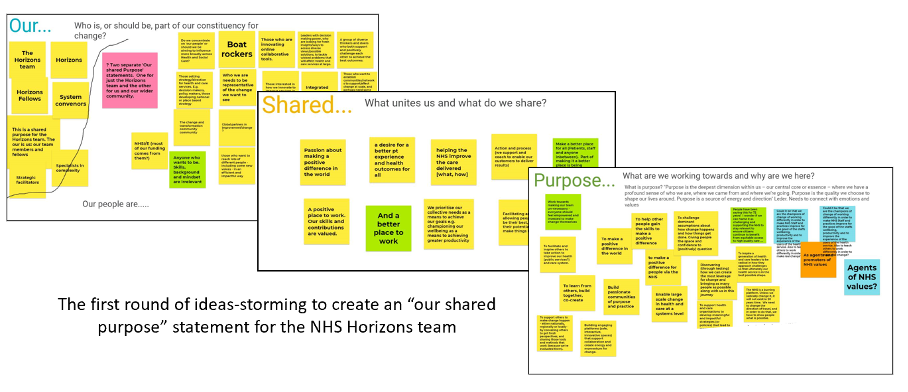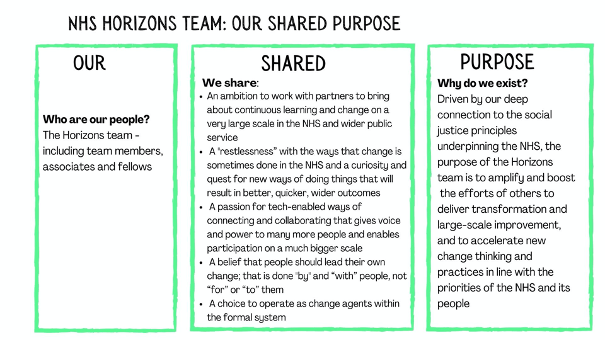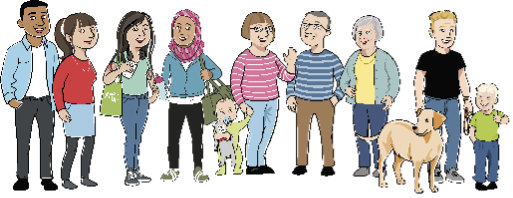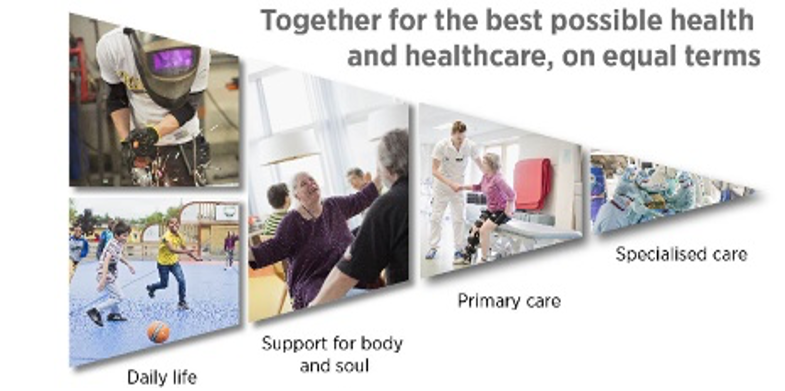We have created a set of “seven simple rules” for leaders who want to create tomorrow today, based on our collective learning over seven decades as leaders and internal change agents in the health and care systems in England and in Sweden and the work we have done with leaders in health and care in any other countries.
This is the second of eight blogs that we will be posting on BMJ Leader over the coming weeks. You can read the first blog where we set out our approach to creating the simple rules here.
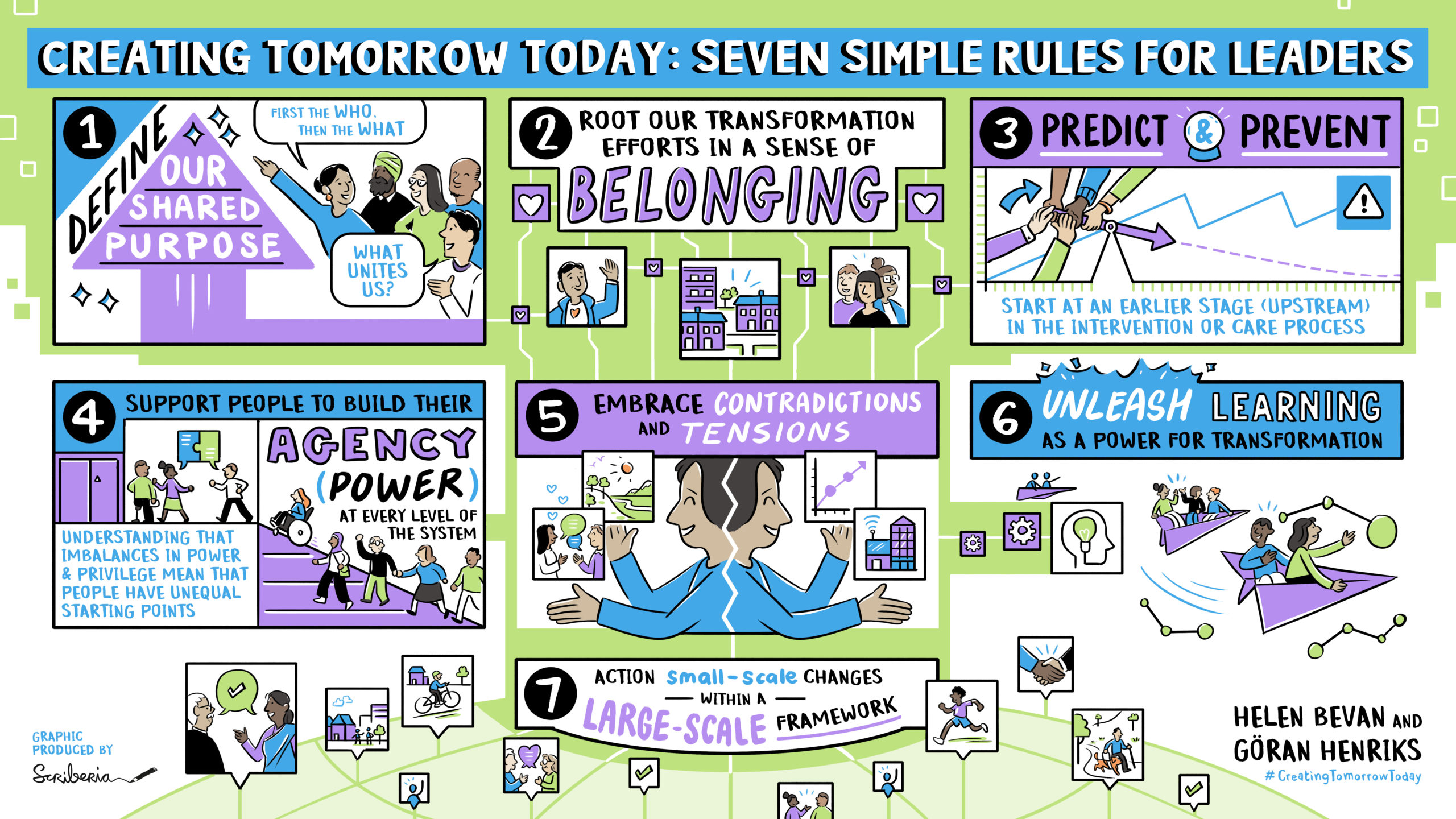
Rule no 1: Define our shared purpose
Defining, articulating and continuously re-articulating ‘our shared purpose’ is the guiding light for any team, network or community involved in a change process that involves people. A shared sense of purpose, grounded in universal values, is the most powerful source of energy for action. The time and effort that goes into this at the early stage of a change process and/or at an early stage of team formation, and in continuing to reflect on it as change progresses, is likely to reap significant dividends.
Defining “our shared purpose” creates the conditions for developing a group of stakeholders (people who share a common interest in the change) into a constituency for transformation – a community of people who are standing together to realise a common purpose.
Each of the three words is important when it comes to setting the foundations for transformational change. The focus is different, depending on who the “our” is:
- The “our” are people who are being brought together as a constituency for a transformation effort or initiative, often for the first time
OR
- The “our” are members of a pre-existing team within an organisation or system
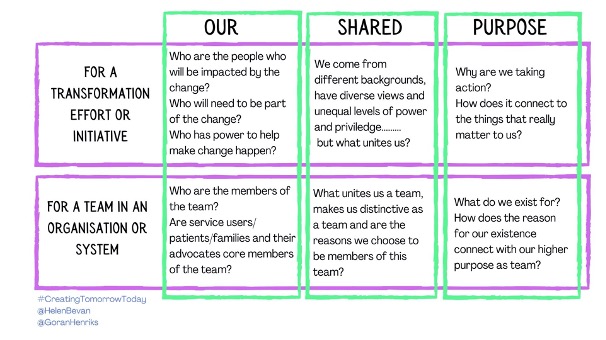
The “our”: who are our people?
Starting with “our” is a fundamental part of our approach to change. To quote Jim Collins: “First who, then what”. Traditional change management approaches typically set the goal first (the “what”), then seek to mobilise people or persuade them to buy-in to the change (the “who”). We flip this. We want to get people engaged first, and then figure out the direction to go in, recognising that transformation is embodied in people and in relationships.
Starting with “our” for a transformation effort or initiative means identifying and mobilising everyone who will be impacted by the change or who we want or need to be part of the process. Our constituency for change needs to include people with formal power, that is, organisational leaders who will make resourcing decisions. It also needs to include people with informal power, influencers and community leaders, who can make or break the change.
We developed a model for thinking about this, in our context of health and care. It is based on three groups (with overlapping interests): the people, the givers of service and the leaders of the system.
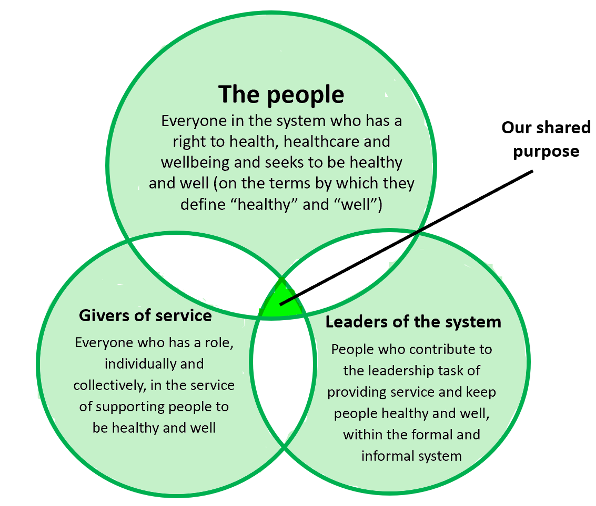
Many handbooks and toolkits for change talk about the relationship between organisations and communities (the people and the leaders) or between the givers of service and the leaders (how to make change happen inside an organisation). Very little of the existing change literature focusses on the relationship between the three. All three groups need to be integral to “our” constituency.
Part of the same team
There is an important philosophical point underpinning these definitions of groups. Often, we see health and care transformation plans that aim to “wrap services around the person/patient” and/or make services more “person/patient centred”. Our perspective is that we view the person/patient not as the centre of activity but as a core and equal member of the health and care team.
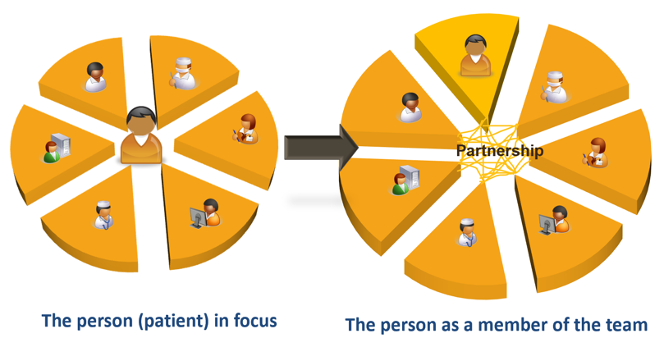
In our third blog, we will discuss how we create a sense of belonging which is a crucial part of building a constituency for change.
What shared purpose is (and what it isn’t)
It’s important to think about what we mean by shared purpose. When we work with groups to develop a shared purpose, people (and particularly formal leaders) often confuse purpose and aim.
| Shared purpose seeks to make explicit the reason behind something that is being done. Purpose defines WHY we are doing what we are doing, and WHAT we hope to achieve from it
Example: Older people who are inpatients in hospital are deteriorating because they are immobilised in bed when we can take action to prevent it. Our purpose is to make sure that every person in a hospital bed gets mobilised when they are ready (clinically and personally), and every person gets choice and chance for the future life they want (taken from #EndPJParalysis) |
| An aim is setting a determined course in order to achieve a set goal within a specific timescale through concrete actions
Example: By 1st April 2021, we will transfer every patient from an inpatient ward to home or other care setting within 24 hours after the patient is deemed ready to transfer |
We need both shared purpose and aims for transformation, but purpose needs to come first. Purpose defines the aim and puts it in the context of the bigger picture. In the context of a pre-existing team, building a collective sense of shared purpose and connecting each individual to the mission of the system makes the work of transformation much more meaningful. Teams who think and work together with a sense of shared purpose are often the happiest and the most successful.
Sharing a purpose in a work team is not just about agreeing on a goal, it is also about connecting at a level of values and emotions, being clear about why we do the things we do, and how the works done solves a real need for the people and supports the wellbeing of the givers of care.
How do we create our shared purpose?
Creating a statement of “our shared purpose” with the constituency or team is typically an excellent investment of time. It builds strong foundations and relationships for change and it is something we can keep referring back to, to make sense of things, as the change progresses. There are multiple ways to do this but, in our experience, there are four key aspects:
- Prepare for a messy, complex process, not a linear process
Creating an “our shared purpose” statement is not an easy or straightforward process. It takes multiple cycles of work. Often a group starts by defining the “our” and realises that they have been too narrow in their definition of constituency and they have to begin again with a wider group of people.
It’s difficult to create the statement in one go with a large group representing the constituency. Often, we will ideas-storm with a bigger group of people, then a smaller group will process the outputs and create a prototype statement for others to review. Whilst having a statement of purpose is a key component of transformation, it is not a good start if we bring together big groups of people for hour after hour trying to write the statement by committee. It can actually create frustration and spoil relationships, rather than build them. In addition, it’s often impossible to get representatives of the whole constituency in one place at one time to create the statement (synchronous working) so we have to work asynchronously, checking in with different people at different times.
We need to define a statement that is “good enough”; that is, we create something we can keep coming back to as the change progresses, giving focus and meaning to our shared work. It doesn’t have to be perfect. So, at some point after we started to work on the statement of purpose, we will produce a statement that everyone can live with, allowing us to divert our energies to making the change we want to see happen, based on the collective purpose we have set out in the statement.
- Create a safe space (or spaces) for discussion
In the current circumstance of the pandemic this is likely to be online. The whole constituency should be represented with multiple diverse voices. The process needs to be well planned and facilitated. Often, we work with a design team (a cross-section of the constituency) in advance to co-create the initial session. Within the group there are likely to be very big differences in level of power and privilege. We need everyone to feel safe and everyone to feel they belong in the group. That’s why we always create clear ground rules and facilitate the process so that everyone has a voice and there are no HIPPOs (highest paid person’s views count the most).
- What unites us: find the commonalities
We often start with each person telling their own story about why this change is important to them. Often, we ask people to prepare this in advance and to select an image that represents their story, as pictures help us to connect at the level of values and emotions. The Unsplash website has more than a million free images to choose from. We then collectively identify the parts of the stories that unite the group. We also need to discuss differences and how we will overcome them. We seek to capture some statements that reflect the shared values, understanding the views, values and ambitions of the group.
- Define our purpose
We consider how the sense of “us” (shared values and ambitions) can be translated into a statement of shared purpose that we can all unite around. We need to watch our language and perspective: for instance, if we have an imbalanced group with more care givers than people, we can end up creating a purpose which is about a service role and not about a shared purpose. Often when we’re facilitating shared purpose statements, we encourage participants to seek a higher level of purpose. It’s about connecting with purpose as the deepest dimension within us – where we have a profound sense of who we are, why we do the things we do and where we are going.
| A case study in shared purpose 1:
The NHS Horizons team Helen is a part of the NHS Horizons team. The Horizons team is a group within the English National Health service that supports teams, networks and communities to deliver large scale change in line with NHS priorities. Everyone in the Horizons team was invited to take part in a process to create a statement of “our shared purpose”. This was an entirely virtual and largely asynchronous process, that enabled lots of people to contribute but made best use of their time. The team set up a Google Jamboard that mirrored the elements of the “our shared purpose” framework and asked each member of the team to contribute their thoughts across each of the three elements of our + shared + purpose. This style of working allowed team members to reflect, build and layer contributions at their own pace over the course of a week – frequently checking the jamboard to add contributions. At the end of the week, there was a review at the team meeting to look at everyone’s contributions.
The team moved to understanding the “our” (it was about team rather than a statement for the wider improvement community), but more work was needed on the “shared” and “purpose” elements. A sub-group was convened to create a prototype version of the purpose statement and there were more iterations before the current version was produced (below):
The process of defining “our shared purpose” took place in parallel to team development sessions with the Horizons team. Team members were able to reflect on their roles in response to the pandemic and what had been learnt as well as looking to the future, to the impact that the team might be able to make. Having this clear shared purpose enabled team members to be bolder and more ambitious but also built humility and quest for collaboration as the purpose made clear that impact only comes through partnership and supporting other people to be successful. |
|
A case study in shared purpose 2: Region Jönköping County, Sweden Goran is a leader of Region Jönköping County. The region achieves some of the best health outcomes in Sweden, based on a twenty plus-year mission to improve the health of the population. In 1997, leaders of the health system developed a compelling vision for the people of Region Jönköping County on the theme of “for a good life in an attractive region”. On its own, this vision was transformational as it framed health in the widest possible terms, prioritising helping people to live healthy lives rather than just focusing on an effective health and care delivery system. As time progressed and the leaders became more mature in their system thinking, they realised that vision was not enough. If they wanted to accelerate population health and reduce health inequalities, they needed to build collaboration with partners across the region, create a region-wide constituency for transformation. They sought to build shared purpose amongst the citizens of Region Jönköping County, the givers of service and the system leaders.
Bringing the constituency together, they created a statement of shared purpose: Together for best possible health and healthcare, on equal terms. They unified the purpose by connecting it to a narrative based on a series of “personas”, Esther, Britt-Marie and Sigge. These are fictional characters but based on the real-life experiences of people who live in Region Jönköping County. When designing a health and care system, they start by asking “what would Britt-Marie, or Sigge, or Esther want?”.
“Together for the best possible health and equal care”, means that the greatest emphasis of the system is on enabling people in their daily life and integrated support for body, mind and soul. When it comes to the formal health system, primary care becomes the first choice and the natural coordinator for people’s health and care needs throughout life. Shared purpose leads to aligned working between partners: health centres, clinics and homecare services, where collaborative care planning. Preventive measures for a relatively small group of the sickest residents contribute to better care, fewer care opportunities, less need for care places and less hospitalisation. The public health system is an integral part of the shared purpose, supporting the residents of the county to be as active as possible and enhancing quality of life. The constituency for change is broad, including the county’s municipalities, authorities, organisations and civil society. By multiple measures of health and healthcare outcomes, Region Jönköping County gets some of best results in the world To quote Nilofer Merchant “Shared purpose allows many communities to engage with us without us having to invest resources in controlling their actions”.
|
And finally, we should remember: the most profound level of purpose in health and care is compassion and love
When we (Helen and Goran) are working with groups to develop a shared purpose, our coaching advice is often “take your purpose statement to a higher level of purpose”. At the most profound level, our purpose is about compassion and love. It is about our deep affiliation with the moral purpose of the health and care system and our goal of improving health for every individual and for whole populations, starting from a point of deep inequality. We translate this into action by leading with love; committing to, connecting with, affirming and making things meaningful for those we serve (and as leaders we serve both the people and the service-givers). We are able to make our greatest contributions, individually and collectively, when we work in a loving environment that is psychologically safe, enabling everyone to do their best, fulfilling our higher purpose. Love is a unifying force in the co-production of service, and it builds collective power for change.
Key questions to reflect on in blog two:
- Who are your people: who should be part of your constituency for change?
- What unites everyone in your constituency?
- What is your shared purpose, beyond aims for improvement?
- What process can you use to define your shared purpose with your constituency for change in an inclusive way that will lead to lasting change?
Please join in the conversation on Twitter, adding #CreatingTomorrowToday and @BMJLeader to your tweets.
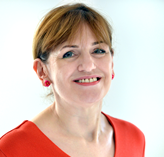
Helen Bevan
Helen Bevan @HelenBevan is Chief Transformation Officer with the NHS Horizons team, England
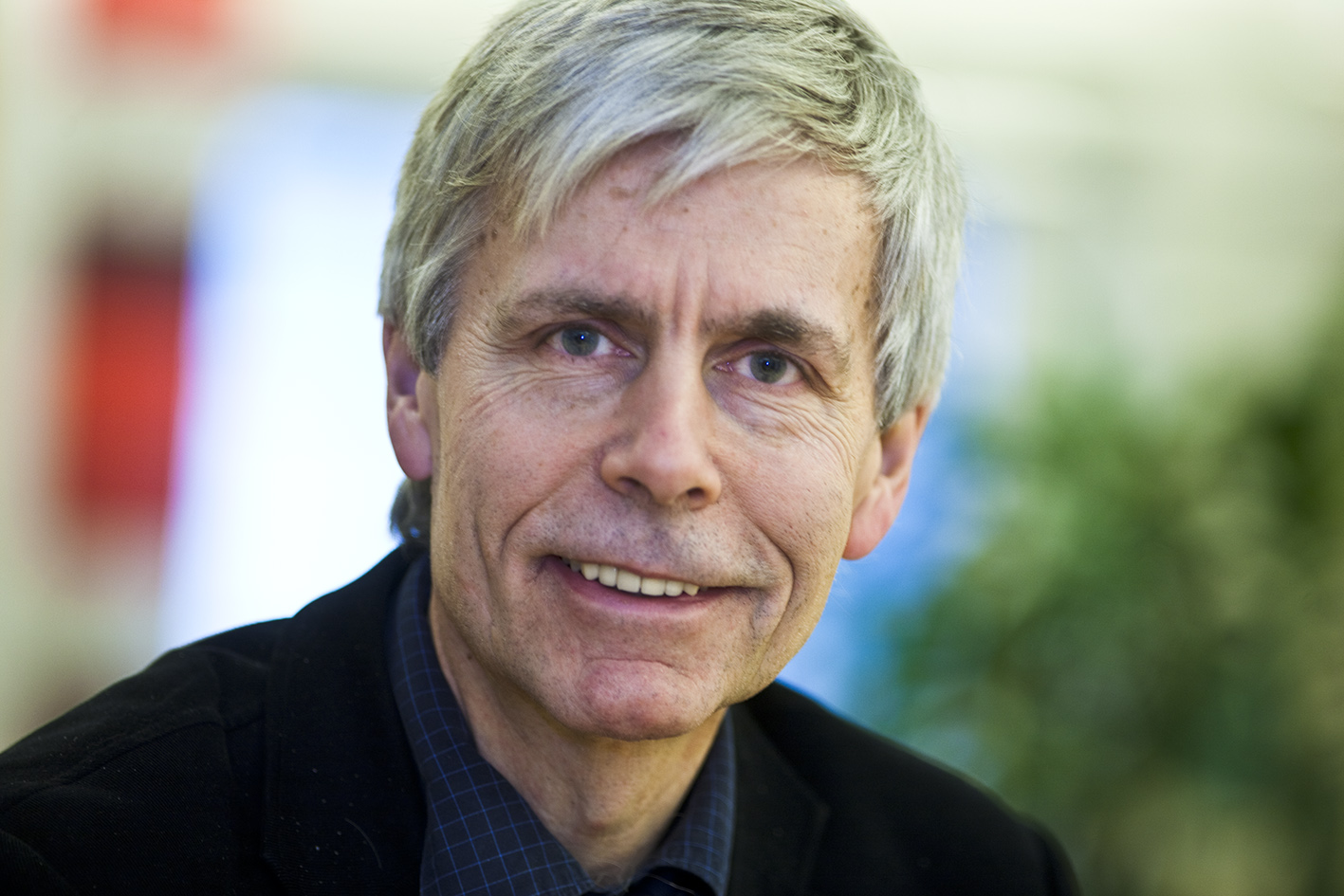
Göran Henriks
Göran Henriks @GoranHenriks is Chief Executive of Learning and Innovation with Region Jönköping County, Sweden
Declaration of interests
We have read and understood the BMJ Group policy on declaration of interests and declare the following interests: none.
